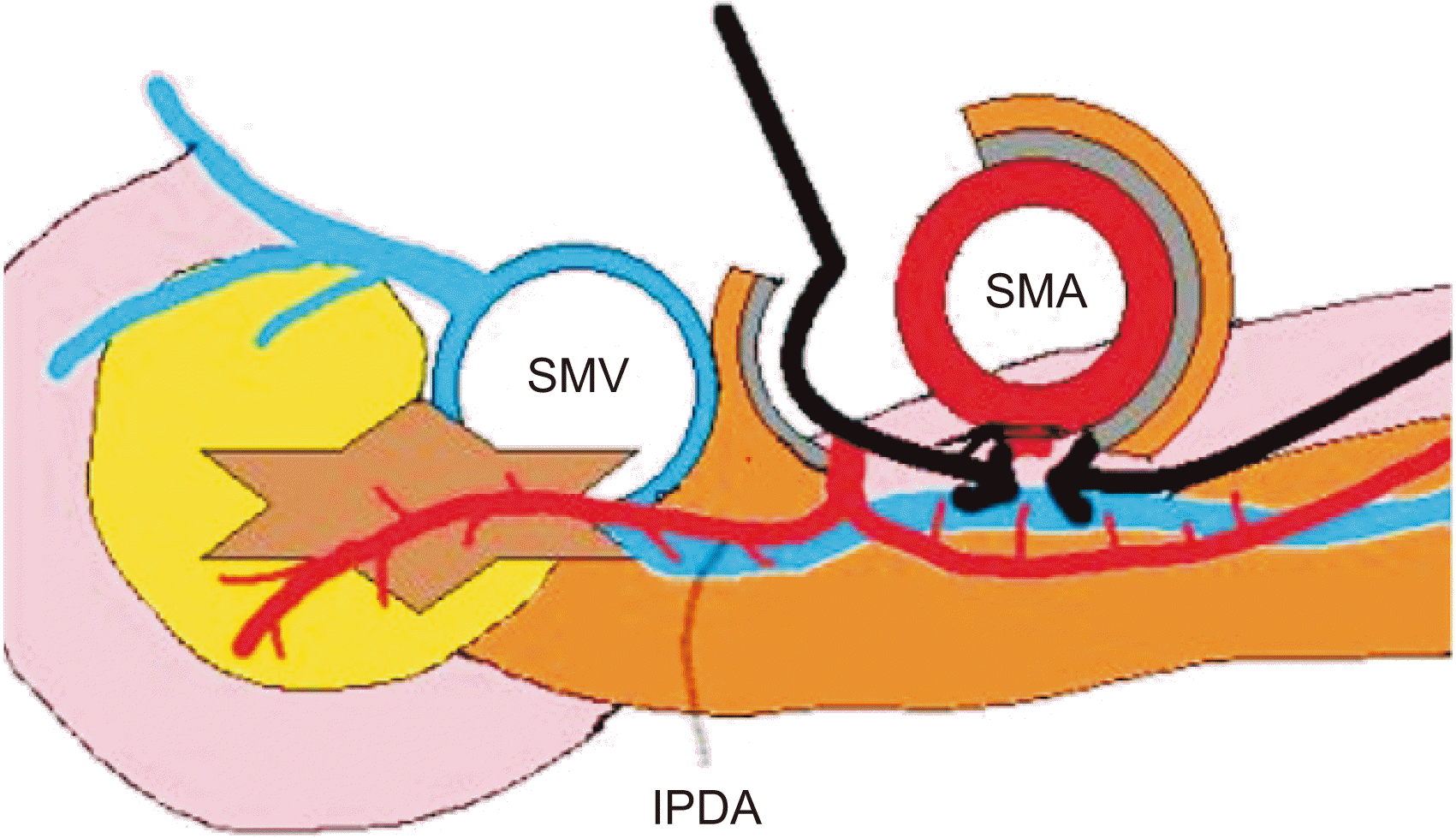1. McGuigan A, Kelly P, Turkington RC, Jones C, Coleman HG, McCain RS. 2018; Pancreatic cancer: a review of clinical diagnosis, epidemiology, treatment and outcomes. World J Gastroenterol. 24:4846–4861. DOI:
10.3748/wjg.v24.i43.4846. PMID:
30487695. PMCID:
PMC6250924.

3. Ferlay J, Soerjomataram I, Dikshit R, Eser S, Mathers C, Rebelo M, et al. 2015; Cancer incidence and mortality worldwide: sources, methods and major patterns in GLOBOCAN 2012. Int J Cancer. 136:E359–E386. DOI:
10.1002/ijc.29210. PMID:
25220842.

4. World Health Organization. 2015. World health statistics 2015. World Health Organization;Geneva:
5. Bosetti C, Lucenteforte E, Silverman DT, Petersen G, Bracci PM, Ji BT, et al. 2012; Cigarette smoking and pancreatic cancer: an analysis from the International Pancreatic Cancer Case-Control Consortium (Panc4). Ann Oncol. 23:1880–1888. DOI:
10.1093/annonc/mdr541. PMID:
32937733. PMCID:
PMC3629994.

6. Wang YT, Gou YW, Jin WW, Xiao M, Fang HY. 2016; Association between alcohol intake and the risk of pancreatic cancer: a dose-response meta-analysis of cohort studies. BMC Cancer. 16:212. DOI:
10.1186/s12885-016-2241-1. PMID:
26968702. PMCID:
PMC4788838.

8. Correa-Gallego C, Dinkelspiel HE, Sulimanoff I, Fisher S, Viñuela EF, Kingham TP, et al. 2014; Minimally-invasive vs open pancreaticoduodenectomy: systematic review and meta-analysis. J Am Coll Surg. 218:129–139. DOI:
10.1016/j.jamcollsurg.2013.09.005. PMID:
24275074.
9. de Rooij T, Lu MZ, Steen MW, Gerhards MF, Dijkgraaf MG, Busch OR, et al. 2016; Minimally invasive versus open pancreatoduodenectomy: systematic review and meta-analysis of comparative cohort and registry studies. Ann Surg. 264:257–267. DOI:
10.1097/SLA.0000000000001660. PMID:
26863398.
10. Demir IE, Jäger C, Schlitter AM, Konukiewitz B, Stecher L, Schorn S, et al. 2018; R0 versus R1 resection matters after pancreaticoduodenectomy, and less after distal or total pancreatectomy for pancreatic cancer. Ann Surg. 268:1058–1068. DOI:
10.1097/SLA.0000000000002345. PMID:
28692477.

11. Geer RJ, Brennan MF. 1993; Prognostic indicators for survival after resection of pancreatic adenocarcinoma. Am J Surg. 165:68–72. discussion 72–73. DOI:
10.1016/S0002-9610(05)80406-4. PMID:
8380315.

12. Nitecki SS, Sarr MG, Colby TV, van Heerden JA. 1995; Long-term survival after resection for ductal adenocarcinoma of the pancreas. Is it really improving? Ann Surg. 221:59–66. DOI:
10.1097/00000658-199501000-00007. PMID:
7826162. PMCID:
PMC1234495.

14. Sabater L, Cugat E, Serrablo A, Suarez-Artacho G, Diez-Valladares L, Santoyo-Santoyo J, et al. 2019; Does the artery-first approach improve the rate of R0 resection in pancreatoduodenectomy? a multicenter, randomized, controlled trial. Ann Surg. 270:738–746. DOI:
10.1097/SLA.0000000000003535. PMID:
31498183.

15. Inoue Y, Saiura A, Oba A, Kawakatsu S, Ono Y, Sato T, et al. 2019; Optimal extent of superior mesenteric artery dissection during pancreaticoduodenectomy for pancreatic cancer: balancing surgical and oncological safety. J Gastrointest Surg. 23:1373–1383. DOI:
10.1007/s11605-018-3995-3. PMID:
30306451.

16. Varadhachary GR, Tamm EP, Abbruzzese JL, Xiong HQ, Crane CH, Wang H, et al. 2006; Borderline resectable pancreatic cancer: definitions, management, and role of preoperative therapy. Ann Surg Oncol. 13:1035–1046. DOI:
10.1245/ASO.2006.08.011. PMID:
16865597.

17. Tempero MA, Malafa MP, Al-Hawary M, Asbun H, Bain A, Behrman SW, et al. 2017; Pancreatic adenocarcinoma, version 2.2017, NCCN Clinical Practice Guidelines in Oncology. J Natl Compr Canc Netw. 15:1028–1061. DOI:
10.6004/jnccn.2017.0131. PMID:
28784865.

18. Katz MH, Pisters PW, Evans DB, Sun CC, Lee JE, Fleming JB, et al. 2008; Borderline resectable pancreatic cancer: the importance of this emerging stage of disease. J Am Coll Surg. 206:833–846. discussion 846–848. DOI:
10.1016/j.jamcollsurg.2007.12.020. PMID:
18471707. PMCID:
PMC5901743.

19. Ramacciato G, Nigri G, Petrucciani N, Pinna AD, Ravaioli M, Jovine E, et al. 2016; Pancreatectomy with mesenteric and portal vein resection for borderline resectable pancreatic cancer: multicenter study of 406 patients. Ann Surg Oncol. 23:2028–2037. DOI:
10.1245/s10434-016-5123-5. PMID:
26893222.

20. Ravikumar R, Sabin C, Abu Hilal M, Bramhall S, White S, Wigmore S, et al. 2014; Portal vein resection in borderline resectable pancreatic cancer: a United Kingdom multicenter study. J Am Coll Surg. 218:401–411. DOI:
10.1016/j.jamcollsurg.2013.11.017. PMID:
24484730.

21. Varty PP, Yamamoto H, Farges O, Belghiti J, Sauvanet A. 2005; Early retropancreatic dissection during pancreaticoduodenectomy. Am J Surg. 189:488–491. DOI:
10.1016/j.amjsurg.2005.01.007. PMID:
15820467.

22. Ironside N, Barreto SG, Loveday B, Shrikhande SV, Windsor JA, Pandanaboyana S. 2018; Meta-analysis of an artery-first approach versus standard pancreatoduodenectomy on perioperative outcomes and survival. Br J Surg. 105:628–636. DOI:
10.1002/bjs.10832. PMID:
29652079.

23. Horiguchi A, Ishihara S, Ito M, Nagata H, Shimizu T, Furusawa K, et al. 2007; Pancreatoduodenectomy in which dissection of the efferent arteries of the head of the pancreas is performed first. J Hepatobiliary Pancreat Surg. 14:575–578. DOI:
10.1007/s00534-006-1198-x. PMID:
18040623.

24. Inoue Y, Saiura A, Yoshioka R, Ono Y, Takahashi M, Arita J, et al. 2015; Pancreatoduodenectomy with systematic mesopancreas dissection using a supracolic anterior artery-first approach. Ann Surg. 262:1092–1101. DOI:
10.1097/SLA.0000000000001065. PMID:
25587814.

26. Negoi I, Hostiuc S, Runcanu A, Negoi RI, Beuran M. 2017; Superior mesenteric artery first approach versus standard pancreaticoduodenectomy: a systematic review and meta-analysis. Hepatobiliary Pancreat Dis Int. 16:127–138. DOI:
10.1016/S1499-3872(16)60134-0. PMID:
28381375.

27. Cho A, Yamamoto H, Nagata M, Takiguchi N, Shimada H, Kainuma O, et al. 2009; Comparison of laparoscopy-assisted and open pylorus-preserving pancreaticoduodenectomy for periampullary disease. Am J Surg. 198:445–449. DOI:
10.1016/j.amjsurg.2008.12.025. PMID:
19342003.

28. Song KB, Kim SC, Lee W, Hwang DW, Lee JH, Kwon J, et al. 2020; Laparoscopic pancreaticoduodenectomy for periampullary tumors: lessons learned from 500 consecutive patients in a single center. Surg Endosc. 34:1343–1352. DOI:
10.1007/s00464-019-06913-9. PMID:
31214805.







 PDF
PDF Citation
Citation Print
Print




 XML Download
XML Download